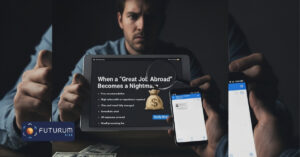Winning by Instinct: Why Litigation Lawyers Need to Master Behavioural Detection
Litigation is as much a psychological duel as it is a legal one. While the facts may be written in black and white, the truth often lives in the grey areas, between the lines of a witness’s testimony, in the pauses of a client’s briefing, or in the subtle tension across a negotiation table. For litigation lawyers, mastering behavioural detection isn’t a nice-to-have; it’s a decisive edge. And in high-stakes environments, that edge can mean the difference between a strategic win and a catastrophic blindside.
Behavioural detection, the ability to observe, interpret and act on non-verbal and verbal cues, has become one of the most powerful, yet underutilised, tools in a lawyer’s arsenal. While it’s long been associated with security and intelligence work, the application in the legal world is far more profound than many realise.
The Courtroom as a Stage: Detecting Deception in Witnesses
Think of a courtroom like a stage. Every person who takes the stand performs a role, but not every performance is genuine. Witnesses, whether lying, exaggerating, or simply uncertain, rarely broadcast dishonesty overtly. Instead, their truth, or lack thereof, is revealed in micro-behaviours: subtle facial expressions, shifts in tone, or body language that doesn’t quite match their words.
For a litigator trained in behavioural detection, these moments are gold. For example, when a witness’s words insist on certainty, but their tone wavers or they blink excessively under pressure, that incongruence can point to discomfort or even deceit. It’s not about being Sherlock Holmes in a robe, it’s about building a tactical awareness that sharpens your questioning and highlights exactly where to press.
Cross-examination isn’t just about catching someone out. It’s about applying pressure in the right places and watching how someone responds under stress. Those responses, pauses, deflections, and unconscious gestures can reveal where the cracks are forming.
What to watch for during cross-examination:
- Before asking difficult questions, observe the witness during a general, non-threatening discussion to establish their natural behaviour. Then watch for deviations when sensitive topics are introduced.
- Words say one thing, but the body says another, such as nodding while saying “no” or shrugging while affirming certainty.
- Repeated body movements like foot tapping, clenched fists, or tightening of the jaw when certain subjects come up, these “tells” can indicate discomfort or dishonesty.
- A sudden pause before answering a straightforward question can suggest internal conflict or the need to construct a lie.
These indicators aren’t accusations, they’re cues. They guide where to dig deeper, where to return later, and when to let silence do the heavy lifting.
Know Your Client Before the Courtroom Does
If the courtroom is the main event, your meetings with your client are the dress rehearsals. And we all know how badly a case can go when a client keeps something back, whether out of embarrassment, fear, or a simple misunderstanding of relevance.
Spotting behavioural cues during client conversations is a vital risk indicator. You’re not just listening to what your client tells you, you’re tuning in to how they tell it. If they’re evasive when discussing timelines, if they appear overly rehearsed on specific topics, or become defensive at unexpected moments, those are red flags. They might not be lying, but they could be leaving something out.
By understanding your client’s behavioural baseline early on, you can spot subtle deviations that might signal withheld information. This allows you to dig deeper in a constructive way, well before opposing counsel does it for you, in front of a judge.
Techniques to apply with clients:
- Subtly mimicking body language can encourage clients to open up. When trust increases, inconsistencies in their behaviour are easier to spot.
- Ask non-leading questions, then watch for overcompensated responses or rehearsed narratives. Genuine recall often includes uncertainty, such as “I think it was around…”, while dishonest stories sound overly polished.
- Note when the client touches their face, adjusts clothing, or avoids eye contact during specific lines of questioning. Revisit those points later, gently.
- Ask your client to recount events out of order. Liars often struggle with non-linear timelines, as fabricated stories aren’t as deeply encoded.
Being attuned to your client’s behavioural signals doesn’t just protect you, it prepares them. You’re not just uncovering the truth; you’re shaping testimony that will hold up under pressure.
M&A Negotiations: Reading Between the Lines When the Stakes Are Sky-High
The boardroom may seem far removed from the courtroom, but the stakes are just as high, sometimes higher. In mergers and acquisitions, where the pace is fast and the language polite, it’s easy to miss what’s really going on. That’s where behavioural detection becomes strategic.
When the other side says, “We’ve disclosed everything material,” but shifts their body posture or deflects eye contact when asked about pending litigation or financial liabilities, you’re not just hearing their words; you’re reading their discomfort. That’s your cue to dig, delay, or even walk.
This kind of behavioural reading is particularly valuable in moments when the written documents all look fine. It’s about catching the subtext, the silence, the sudden change in tone when one clause in a 30-page agreement gets mentioned. And in deals worth millions or billions, that subtext can be where the real risk lies.
M&A behavioural tactics to consider:
- A single cue can be misleading, but three or more signals occurring together (e.g., lip compression, gaze aversion, and a stutter) can reliably indicate discomfort or concealment.
- The face, neck, and hands often betray unease. A hand shielding the mouth or sudden neck scratching during financial discussions may warrant a deeper inquiry.
- Silence can be a tactic. Ask a tough question and sit with a pause. Watch for shifting, fidgeting, or quick glances to colleagues; non-verbal consensus-seeking often reveals internal disagreement.
- Reverse questioning: Ask, “What might your team worry we’ll discover post-close?” The reaction, both in words and body, can be more revealing than the answer.
When the pressure is high and the stakes are personal, behaviour rarely lies. It simply needs a trained eye to read it.
Litigation Demands More Than Legal Acumen, It Demands Perception
The use of behavioural detection in legal contexts isn’t theory, it’s rooted in practice and proven across high-stakes environments. Our own approach has been shaped by the expertise of James Ellender, Futurum’s managing director, who leads behavioural detection training across Asia Pacific and beyond. With over 20 years of experience spanning covert operations, law enforcement, and international advisory roles, James brings both academic and operational depth to the table.
James’s early research, focused on the effectiveness of behavioural detection in reducing terrorist threats in public spaces, underpins his methods. But it’s the practical application that matters most to litigators. He led capacity-building efforts globally, helping organisations spot behavioural cues under stress, and he was responsible for developing the ‘Train-the-Trainer’ programme for the FIFA™ World Cup Qatar 2022, equipping over 45,000 officers with skills to recognise hostile intent during live events.
This same science is directly relevant in litigation, where stress behaviours play out in real time. James regularly trains professionals in behavioural interviewing, protective security, and crisis leadership, skills that help legal teams read the room better, ask sharper questions, and avoid costly missteps.
Trained Instincts Are Better Than Lucky Guesses
Behavioural detection is not about gut feelings or guesswork. It’s about methodically observing, testing, and verifying cues. It’s evidence-based, adaptable, and incredibly effective when used well. And unlike most legal skills, it’s rarely taught as part of the standard toolkit.
But for litigation or M&A lawyers who want to stay ahead of the curve, whether in court, behind closed doors, or across the negotiation table, developing these capabilities offers a serious competitive advantage. In a profession built on facts, it’s often the behaviour surrounding those facts that reveals the bigger truth.
Sometimes, the loudest message is the one no one says aloud. The blink before a denial. The breath before a lie. Or the silence that follows a simple question.
And for those who know how to read it, that silence speaks volumes.





